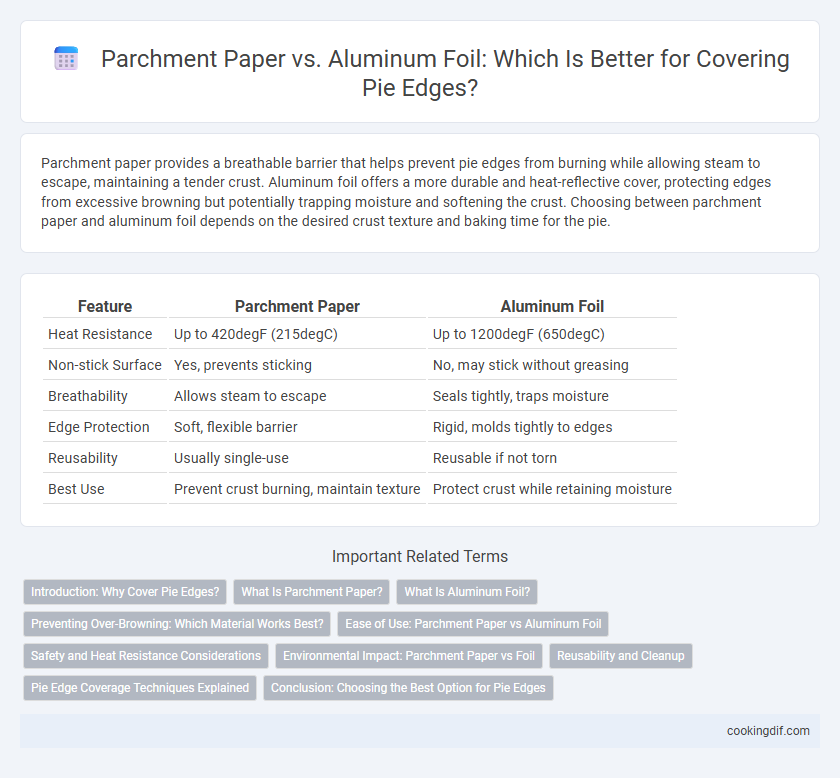Parchment paper provides a breathable barrier that helps prevent pie edges from burning while allowing steam to escape, maintaining a tender crust. Aluminum foil offers a more durable and heat-reflective cover, protecting edges from excessive browning but potentially trapping moisture and softening the crust. Choosing between parchment paper and aluminum foil depends on the desired crust texture and baking time for the pie.
Table of Comparison
| Feature | Parchment Paper | Aluminum Foil |
|---|---|---|
| Heat Resistance | Up to 420degF (215degC) | Up to 1200degF (650degC) |
| Non-stick Surface | Yes, prevents sticking | No, may stick without greasing |
| Breathability | Allows steam to escape | Seals tightly, traps moisture |
| Edge Protection | Soft, flexible barrier | Rigid, molds tightly to edges |
| Reusability | Usually single-use | Reusable if not torn |
| Best Use | Prevent crust burning, maintain texture | Protect crust while retaining moisture |
Introduction: Why Cover Pie Edges?
Covering pie edges prevents crust from burning or becoming overly browned during baking, ensuring an even, golden finish. Parchment paper is breathable and non-stick, allowing steam to escape while protecting delicate edges. Aluminum foil provides a more durable barrier but can trap moisture, potentially leading to soggy crust edges if not carefully monitored.
What Is Parchment Paper?
Parchment paper is a heat-resistant, non-stick paper commonly used in baking to prevent sticking and ensure even cooking. When covering pie edges, parchment paper protects the crust from burning by creating a breathable barrier that allows steam to escape. Its flexibility and moisture resistance make it a preferable choice over aluminum foil, which can trap moisture and cause sogginess.
What Is Aluminum Foil?
Aluminum foil is a thin sheet of metal made from pure aluminum, known for its durability and heat resistance, making it ideal for protecting pie edges during baking. Unlike parchment paper, aluminum foil molds easily around the edges, providing a sturdy barrier that prevents over-browning and burns. Its reflective surface helps distribute heat evenly, ensuring the pie crust cooks uniformly without becoming too dark.
Preventing Over-Browning: Which Material Works Best?
Parchment paper effectively prevents over-browning on pie edges by providing a breathable barrier that allows steam to escape while shielding the crust from direct heat. Aluminum foil offers a more reflective surface that can protect edges but may cause uneven browning due to heat reflection variations. For consistent edge protection and optimal browning control, parchment paper is generally the superior choice.
Ease of Use: Parchment Paper vs Aluminum Foil
Parchment paper offers superior ease of use for covering pie edges due to its flexibility and resistance to sticking, allowing for simple shaping around crusts without tearing. Aluminum foil can be more challenging to mold securely around uneven edges but provides effective heat shielding when carefully folded. Choosing parchment paper reduces the risk of tearing and simplifies removal, enhancing overall pie-baking convenience.
Safety and Heat Resistance Considerations
Parchment paper offers superior heat resistance up to around 420degF, making it ideal for protecting pie edges without risking burning or chemical leaching, unlike aluminum foil which can withstand higher temperatures but may react with acidic pie fillings. Safety-wise, parchment paper is non-toxic and does not release harmful substances when heated, while aluminum foil, if torn or in direct contact with certain foods, can pose health risks due to potential aluminum exposure. Choosing parchment paper minimizes the risk of overbaking and chemical contamination, ensuring a safer, evenly baked pie crust.
Environmental Impact: Parchment Paper vs Foil
Parchment paper is compostable and biodegradable, making it a more environmentally friendly option compared to aluminum foil, which requires extensive mining and energy-intensive production processes. Aluminum foil is recyclable but often ends up in landfills due to contamination with food residue. Choosing parchment paper for covering pie edges reduces waste and minimizes the carbon footprint associated with pie baking materials.
Reusability and Cleanup
Parchment paper offers superior reusability compared to aluminum foil due to its non-stick surface that resists tearing, allowing multiple uses when gently cleaned. Cleanup with parchment paper is typically easier because it prevents pie edges from sticking, reducing residue and grease buildup. Aluminum foil often wrinkles and sticks to the crust edges, making disposal necessary and cleanup more labor-intensive.
Pie Edge Coverage Techniques Explained
Parchment paper provides a breathable barrier that prevents pie edges from overbrowning while allowing steam to escape, preserving crust texture. Aluminum foil offers a sturdy, heat-reflective shield that slows baking around the edges, effectively preventing burning but can sometimes cause sogginess if wrapped too tightly. Choosing between parchment paper and aluminum foil depends on the desired crust finish, with parchment favored for crisp edges and foil for heavier protection.
Conclusion: Choosing the Best Option for Pie Edges
Parchment paper offers a breathable barrier that prevents crust edges from burning while maintaining moisture balance, ideal for delicate pies requiring gentle heat. Aluminum foil provides a more robust, heat-reflective cover that shields edges from overcooking but can trap moisture, potentially leading to sogginess. Selecting between parchment paper and aluminum foil depends on the pie type and baking conditions, with parchment favored for crisp edges and foil preferred for sturdier protection.
Parchment paper vs aluminum foil for covering pie edges Infographic

 cookingdif.com
cookingdif.com